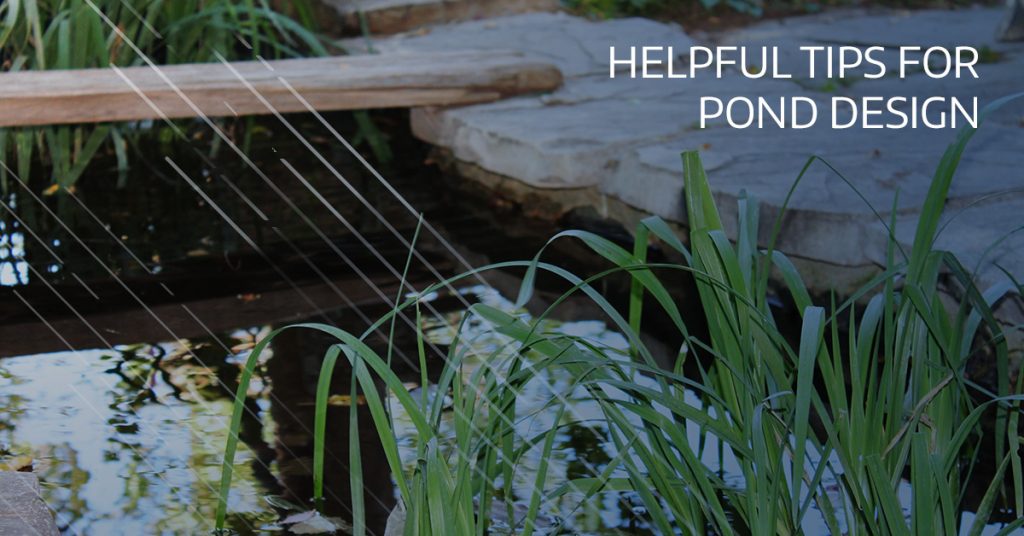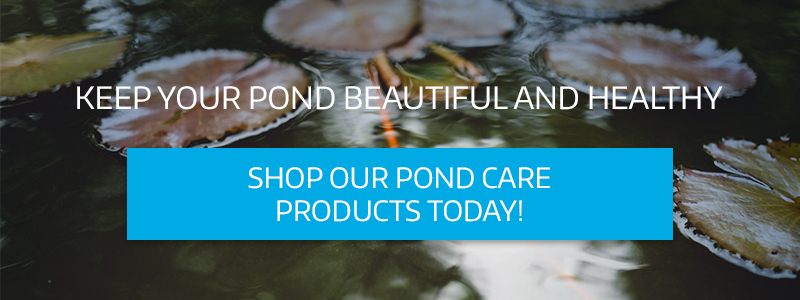Helpful Tips For Your Pond Design

One of the most popular backyard trends for homeowners is the addition of a pond or water garden to their property. Ponds are an easy and wonderful way to improve an outdoor living space as they provide a wonderful aesthetic addition to a home, plus they create a relaxing backyard oasis for those who want to get away from the rest of the world.
When homeowners are considering the addition of a pond or water garden to their property, one of the most important parts of the process is to think of a design that is not only appealing but functional as well.
Because designing a pond can be an overwhelming and stressful task, we thought it would be helpful to put together some essential tips for homeowners related to designing the perfect water garden or pond. While we won’t go too in-depth with the specifics of pond design and pond building, we will cover some crucial tips for homeowners to keep in mind as they lay things out and prepare to have a beautiful pond added to their yards.
Tip #1: Determine the budget
Like all home improvement or addition projects, the first thing to do is establish a budget. While homeowners may have varying opinions, we believe that homeowners’ budgets should be high on the list of factors that determine what they want to do and where they want to go with their pond design. Of course, the larger the pond the more money it will likely cost more for materials, landscaping, supplies, and mechanical devices, like pond filters and pumps. In addition, the bigger the pond is, the more pond supplies it will use over the long run.
Once homeowners are set on building a pond or water garden, it is a good idea to plan out a budget and determine what you can and cannot afford. Investing in building a pond and then not be able to support it, or being frugal on supplies and equipment in order to save a few bucks will not end up working well. Remember, ponds cost more than just than the initial cost to get it up and running. Additional money will have to be invested in pond equipment, supplies, and pond landscaping in the long run in order to maintain a healthy pond or water garden environment. Once homeowners have a realistic budget set for the pond they want, they can continue the pond design planning process.
Tip #2: Plan for space
Each homeowner’s yard size, shape, and terrain will often vary from others, which is why it is necessary to do the proper planning in regards to the size and shape of a pond or water garden. As a first step in the planning stage, it is best for homeowners to attempt to fit a pond in an area as accurately as possible. Building a large pond in a small area can cause a space to cramped and crowded while a small pond in a large yard can seem unusual and insignificant. It is best for homeowners to find a balance between yard and pond size, while maintaining a respect for their set budget, desires, and goals.
The choice of pond liner material will also have an impact of a ponds size and shape, as a preformed liner is set in terms of the layout it provides, while an EPDM pond liner has the flexibility to create a pond or water garden of just about any size and shape. In terms of gallon capacity perform liners are smaller, however, this doesn’t make them a bad choice for homeowners. In fact, for those who have a smaller yard or area when they are planning to have a pond built, a preformed liner will generally be the easiest and convenient option. And, for those who have the yard space and ambition, a larger pond will have fewer limitations than a smaller, or preformed pond. In the end, though, homeowners should strive to build a pond or water garden that fits well in their desired space.
Tip #3: Buy quality pond products and materials
As mentioned above, in order for a pond to operate properly and effectively, certain equipment, products, and materials are needed. Pond pumps and filters are the two most common pieces of pond equipment that work to help keep a pond clean, balance, and healthy and the quality of each piece can influence the way it performs. When building a pond, it is important to do some research and shop around for these items for a pond as prices can vary just as much as the level of quality. However, what’s most important for homeowners when shopping for quality pond equipment and products is to ensure the pond equipment they purchase or have installed is more than capable for the needs of their pond. Consider the following issues.
A common problem that many pond owners encounter is the growth of algae. When the weather warms up, algae may begin to bloom and grow wildly. Algae growth is caused by the presence of certain nutrients. These nutrients can come partly from fish waste, which is usually eliminated by a ponds biofilter. Using a filter that is cheap, undersized, or too small for the amount of water in a pond, or if the amount of fish in a pond grows beyond its capacity, certain elements will be left in the water that can cause algae problems or spiked ammonia levels which can be harmful to pond inhabitants. Using an undersized pond pump may cause future problems because they need to drive water through the filter and entire system to sufficiently circulate an adequate amount of water in a set amount of time. If the water happens to circulate through the system slowly, certain parts of the process will be unable to keep up, potentially causing the water quality to go down. Like other components of a pond or water garden, larger pond filters and pumps will likely cost more money, but purchasing a pump or filter that doesn’t meet requirements just to save some cash is not a good idea and will likely cost more money in the long run. It is best to overestimate the demand and size of these pond items accordingly.
Castle Aquatics Tip: When purchasing quality pond products, be sure to include the amount of fish that are estimated to be added later on, which can increase the demand for specific pond equipment, like filters and pumps.
Tip #4: Layout the pond formation
Once homeowners have finished some of the initial steps of planning a pond design, they can begin to layout the formation of the pond or water garden. First, to begin the layout they can use an unused garden hose or long rope and move it around until the shape of their ideal pond is defined. Homeowners can utilize this method as many times as needed in order to get the size and shape that they desire, plus it will help with the visualization of a pond. The layout of a pond can be changed as many times as needed until the digging begins, so it is essential for homeowners to choose a layout they will enjoy. Once homeowners decide on a shape they like, and one that fits into their yard space well, they mark the edges of the layout with spray paint. This will create the perfect stencil to use for digging out the area of the pond. This can be a fun do-it-yourself project for people, or the job can be delegated to a landscaping company or pond builder to help bring their pond project closer to completion.

By following these tips, choosing the right pond design will likely be less overwhelming for homeowners, making the process of adding a pond or water garden to their property much more simplified. Once a design is chosen and the pond installation process has begun, the proper equipment, materials, and products will need to be purchased to ensure that the pond is healthy. For quality pond equipment, materials, and pond care products, there’s not a better spot to shop for pond owners other than Castle Aquatics. Whether you need pond maintenance equipment, pond pumps, or UV pond lights, Castle Aquatics is sure to have the pond products you are looking for. Our certified dealers carry the best pond products, like the PondMAX filters. If you are installing a pond in your yard, get the essential pond products you need, shop at Castle Aquatics today!
 Stocking Design Center
Stocking Design Center  Stocking Dealer
Stocking Dealer  Dealer
Dealer